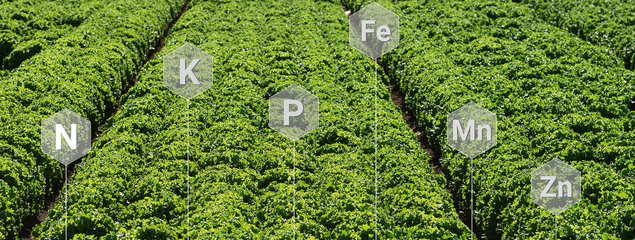
Improve Plant Nutrition
Fertilizer Guidelines for Vegetable Crops in Arizona
Crop Fertilizer Guidelines (3)
Baby Spinach and Baby Leaf (3.5)
The acreage of baby spinach and baby lettuce, collectively referred to as baby leaf, in the Lower Colorado River Region has increased dramatically over the last two decades due to the packaged salad industry (Figure 3-5-1). These crops are grown on 80-84 inch shallow seedbeds and are irrigated with sprinklers throughout the cropping season. The growing period can range from 30-60 days depending on air temperature. The in-season nitrogen (N) uptake of these crops varies with length of growing season, which in turn varies with the timing of crop harvest (Table 3-5-1). High market demand may result in an early harvest and lower biomass and N removal, while lower demand may delay harvest resulting in greater biomass and nitrogen removal. Since the production of baby leaf crops is new to the region, there was no historical database to build on. Thus, the guidelines presented here are entirely based on studies conducted in the region over the last 15 years.
Baby spinach and baby lettuce may require pre-plant or early season application of N fertilizer. In the Lower Colorado River production area, baby leaf crops are often the second crop of the vegetable growing season following fall lettuce, broccoli, or a previous baby leaf crop. When these crops follow another vegetable crop within the same fall-winter-spring cropping cycle, early season N fertilizer application is usually not required. In a survey of fields where baby spinach and baby lettuce were the second crop in a season, the author found less than 14% of the soil samples tested less than 5 ppm nitrate-N (14). In the current fertilizer application guideline, soil nitrate-N of 5 ppm is considered a lower threshold for these crops, below which pre-plant applications of N fertilizer could be required. Pre-plant monoammonium phosphate (MAP) applications are not common for baby leaf crops grown in the region when they follow another crop. Thus, for a second baby leaf crop, if the pre-plant soil nitrate-N test results are less than 5 ppm, then application of about 15 lbs of N/acre with the germination irrigation is recommended (Table 3-5-2). If baby leaf is the first crop following the summer leaching pre-irrigation, pre-plant or early season application of N fertilizer is likely required (Table 2-1-1, Section 2).
While the early season N requirements can be met with the pre-plant MAP application, under conditions where the phosphorus (P) requirements are low, a separate N fertilizer application could be needed. For most production areas in the region, the in-season N fertilizer requirement of baby leaf crops is applied through fertigation with sprinklers. Typically crop water requirements are applied in four to five irrigation events suitably distributed through the season, which allows N application to be spread out over the season in a way that matches the crop requirements. Irrigation application efficiencies in the area can be high (9). Thus, maximum baby spinach and baby lettuce yield can generally be obtained with a seasonal (in-season) N fertilizer application of 150 or less lbs/acre.
Results of sprinkler fertigation studies conducted in 2020 and 2021 on baby spinach and baby lettuce crops (14) showed that adjusting fertigation rates in accordance with crop N uptake can lead to increased crop N use efficiency (Figure 3-5-2). Generalized N fertilization guidelines for these crops are shown in Table 3-5-2. However, these N rates can be adjusted based on results of in-season soil nitrate-N tests. The guideline considers a soil nitrate-N test level of 20 ppm as the lower threshold below which N fertilizer application is required. N fertilizer needs to be applied at a rate of 4 lbs/acre to raise the soil nitrate-N level by 1 ppm. These crops have a short growing period, and therefore the turn-around time for laboratory analysis may not allow for timely N management decisions. In this case, the quick test protocol noted in Section 2.1 can be an alternative.
Split-top-dress applications of N fertilizer are practiced in a small acreage of baby spinach in the region. The product typically used in split-top-dress applications of N fertilizer to baby spinach crop is ammonium sulfate. Studies conducted by the author showed that there is negligible difference in production among different N sources applied with top-dress method. However, the use of the urease and nitrification inhibitors resulted in crop damage when applied with top-dress dry fertilizers (Table 3-5-3).
Baby leaf crops show response to P fertilizer application up to soil P levels of 25 ppm Olsen-P (Table 3-5-4). If these crops are grown as the second crop in a fall-winter-spring cropping cycle, pre-plant application of P fertilizer is typically not needed.
As is the case with other crops, there is no reported case of baby leaf showing yield response to potassium (K) fertilization. However, it is prudent to occasionally conduct soil tests for K and verify that AA K levels are greater than 150 ppm (Section 2.3). The K concentration of baby lettuce and baby spinach leaves should not be less than 4% (Section 4.3).
Soils used for baby spinach production are occasionally marginal in zinc (Zn), making Zn fertilization potentially necessary. The guidelines presented in Table 2-5-1 and Section 2-5, developed based on soil DPTA tests, can be used to determine Zn fertilizer requirements. The soil test based guidelines may need to be complemented with leaf tissue Zn concentration tests. The leaf tissue Zn concentrations in baby spinach and baby lettuce should not be less than 50 ppm (Section 4.3).
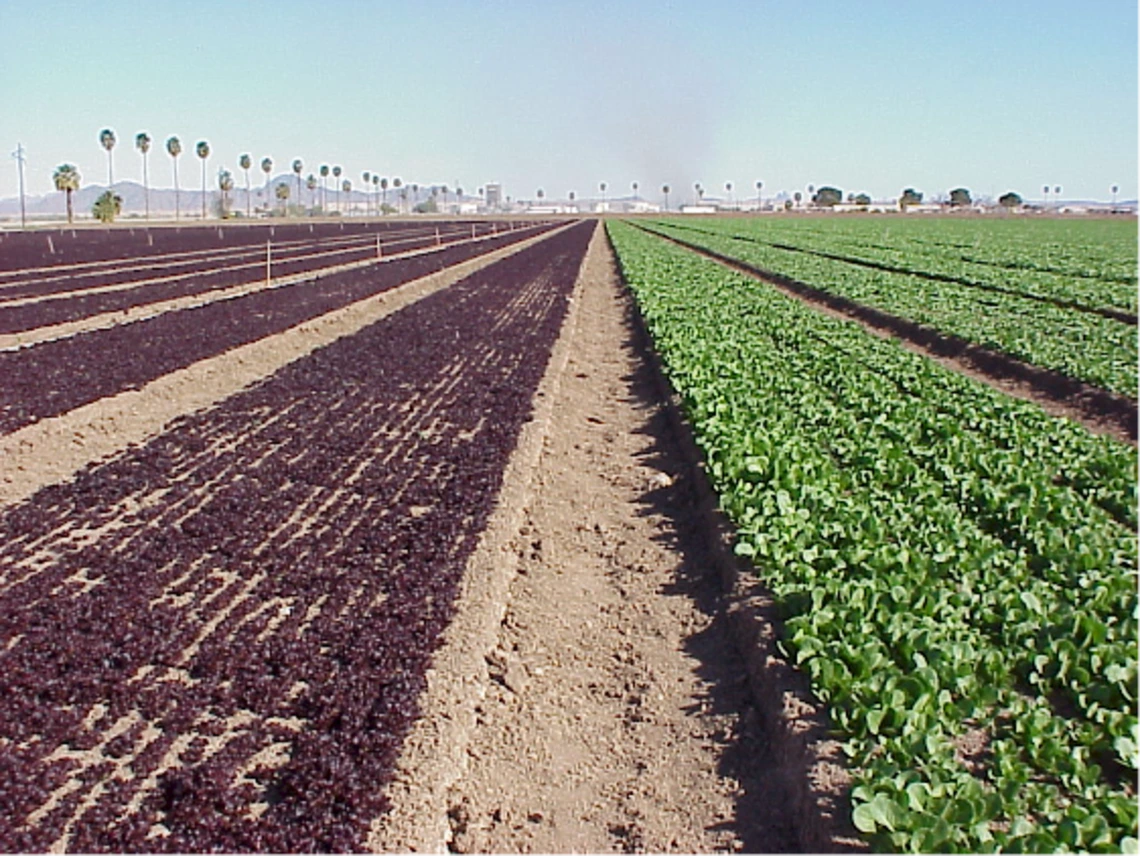
Figure 3-5-1
Baby lettuce and baby spinach in a field near Yuma.
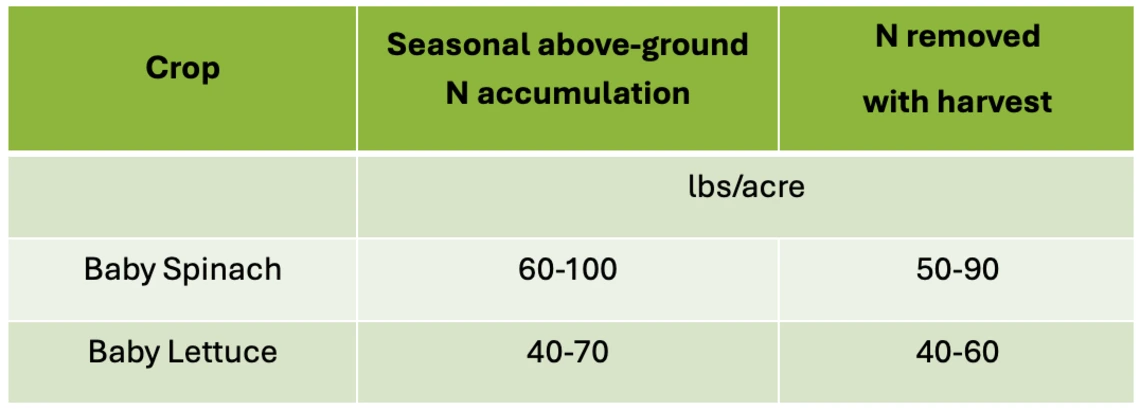
Table 3-5-1
Ranges of total accumulation of N in above-ground crop and N removal with harvest.
Data from (14)
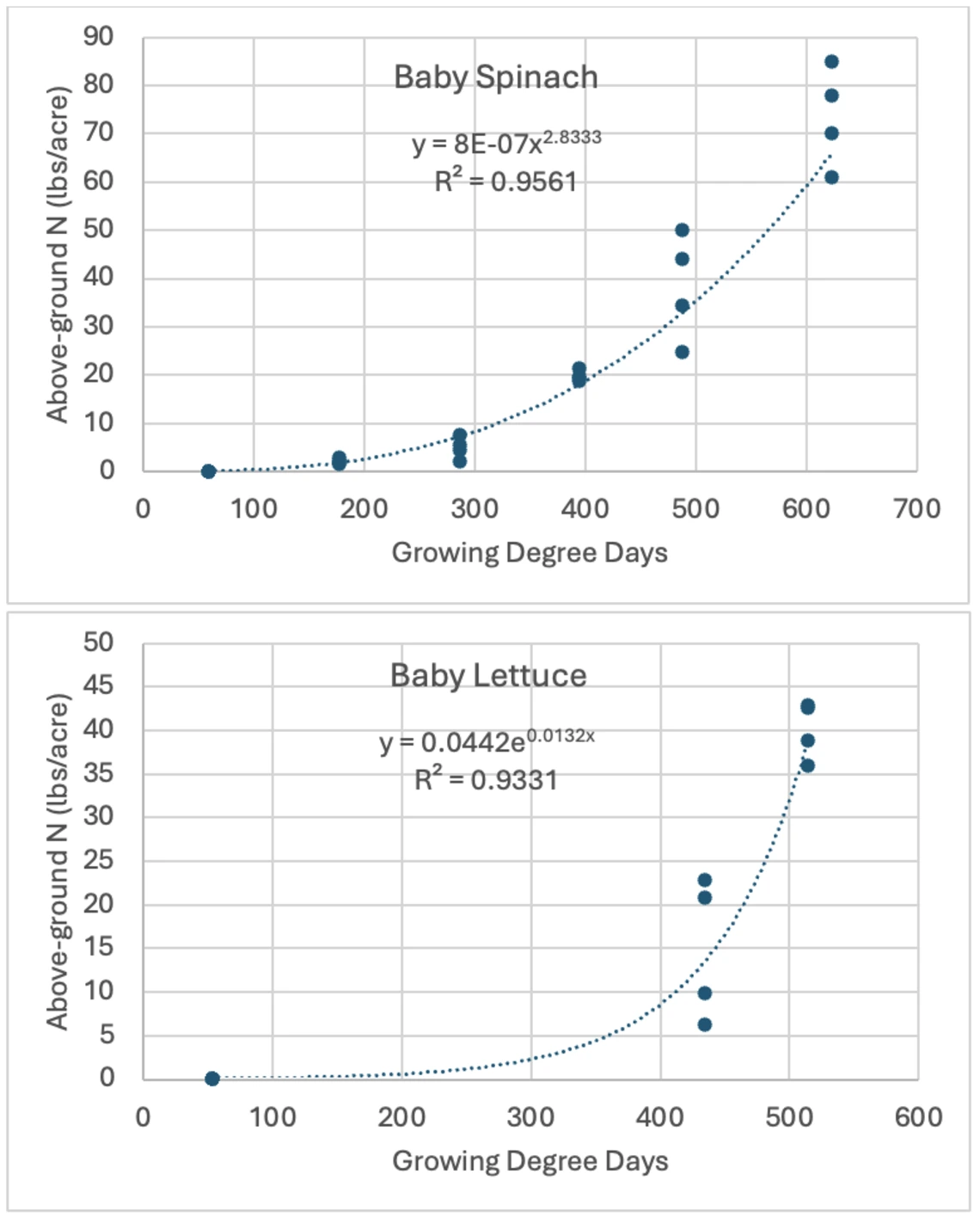
Figure 3-5-2
Typical above-ground N accumulation by baby spianch and baby lettuce in Yuma area.
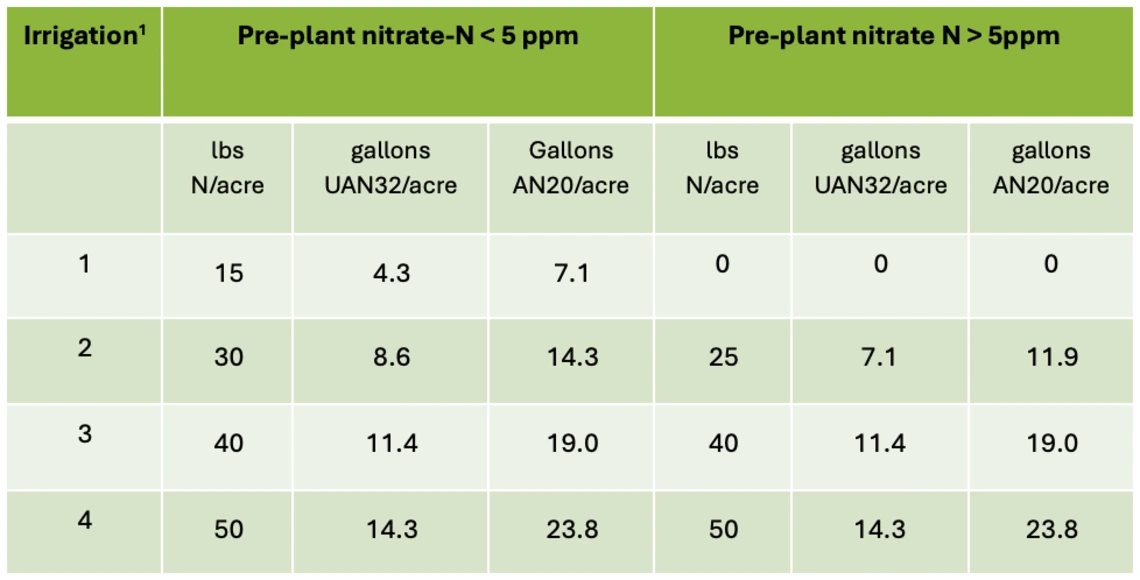
Table 3-5-2
Guidelines for N fertilization of baby spinach and baby lettuce.
1Irrigation 1 is the irrigation of germination and stand established. Subsequent irrigations follow as needed after stand establishment. The N rates are typically by either UAN32 or AN20.
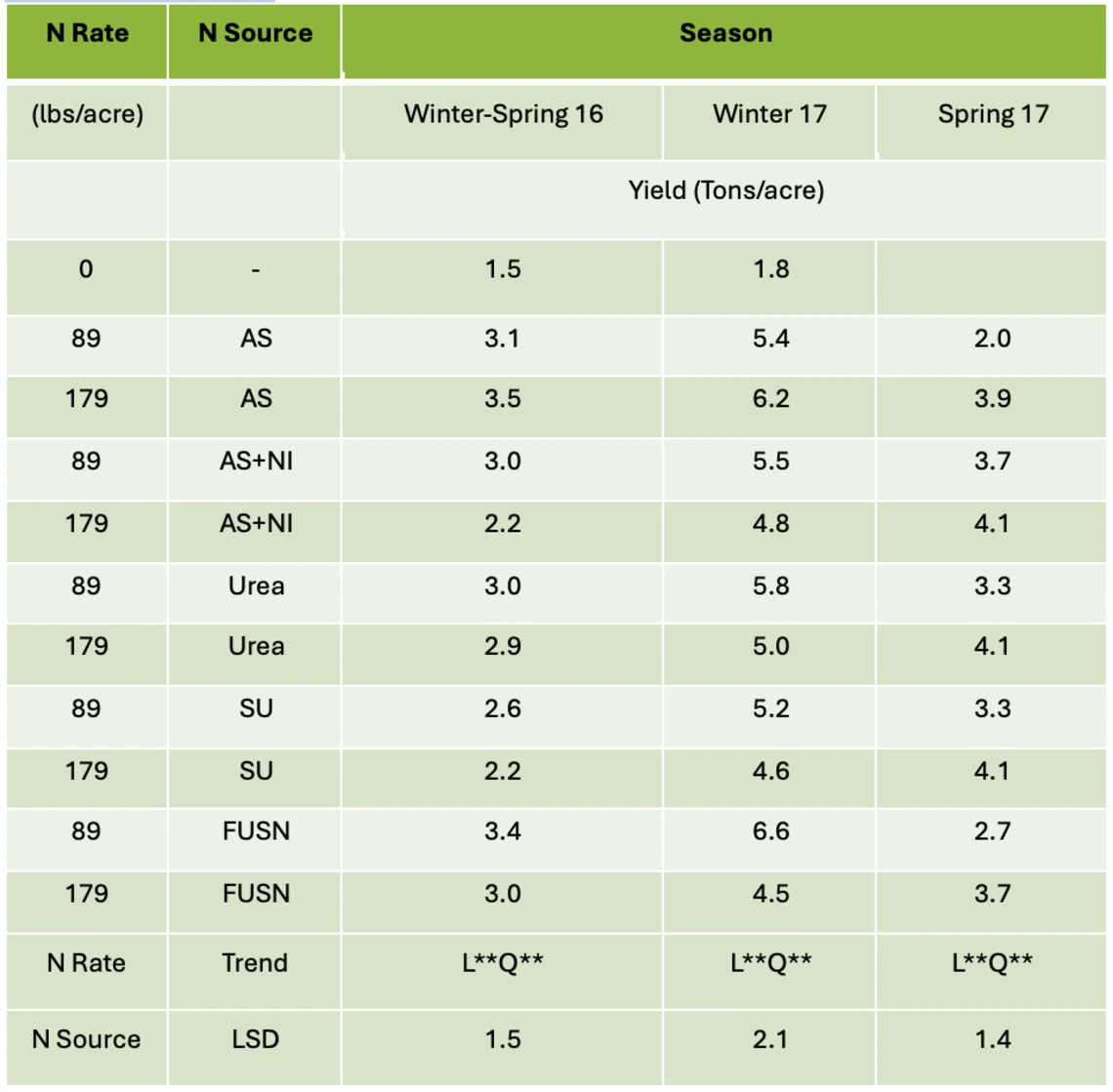
Table 3-5-3
Response of spinach to two split-top-dress N sources in three cropping seasons.
AS is ammonium sulfate; NI is nitrification inhibitor (DMPP); SU is super urea, a commercial urea product stabilized with a urease inhibitor (NBPT) and a nitrification inhibitor (DCB); FUSN is a proprietary technology whereby ammonium nitrate (AN) is fused with ammonium sulfate to eliminate the detonation potential of AN.

Table 3-5-4
Baby leaf P fertilizer guidelines by pre-plant Olsen P soil test.

